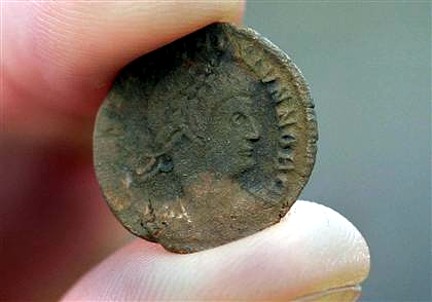Hallan restos romanos durante los trabajos de excavación del Centro Acuático de Londres 2012
Photo: A Roman coin from the period of Roman Emperor Constantine II AD 330-335, is displayed at the Olympic construction site in Stratford east London, Wednesday Nov, 28, 2007. A Roman coin, pottery and a coin from the Iron Age have been found on the site of the aquatics center planned for the London 2012 Olympic Games. Digs on the Olympic Park site have discovered evidence of Iron Age settlement, including fourth-century pottery and a Roman coin from the time of Emperor Constantine II. (AP Photo/John Stillwell/PA) ** UNITED KINGDOM OUT **
John Stillwell / AP Updated: 2:10 p.m. ET November 28, 2007
Restos de piezas de cerámica de la Edad de Hierro y una moneda y una pieza de cerámica romana fueron encontradas en la sede del Centro Acuático en el que se disputarán las pruebas náuticas pertenecientes a los Juegos Olímpicos de Londres en 2012.
Las excavaciones en el Parque Olímpico han descubierto evidencias de un asentamiento de la Edad de Hierro, incluyendo cerámica del siglo cuarto y una moneda romana de la época del emperador Constantino II.
El Museo de Londres ha estado trabajando con la organización de Londres 2012 que está preparando la zona donde se comenzará a construir el Parque Olímpico en la zona este de la ciudad el próximo año.
"Tenemos una extraordinaria oportunidad para hablar de la fascinante historia de la zona baja de Lea Valley antes de que se le dé una nueva vida para los Juegos y las próximas generaciones", afirmó David Higgins, director ejecutivo de la Autoridad de Desarrollo Olímpico.
Durante la Edad de Hierro, el área estuvo rodeada por lagos, ríos y pantanos y los arqueólogos han encontrado partes de utensilios para cocinar empleados por los antiguos habitantes.
Tanto la cerámica como la moneda romana, datadas entre el 330 y 335 d.C, fueron encontradas enterradas en un bosque junto al río. Una cara de la monea muestra dos soldados y dos valores y la otra tiene inscripciones que representa a Constantino II.
Fuente: EP/AP, Londres, 29 de noviembre de 2007
Enlace: http://www.atbnoticias.es/noticia.php?id_seccion=12&id=90780
(2) Roman artifacts found at Londons Olympic site
Pottery and coin date back to the days of Emperor Constantine II
Roman pottery and a coin from the Iron Age have been found on the site of the aquatics center planned for the London 2012 Olympic Games.
Digs on the Olympic Park site have discovered evidence of Iron Age settlement, including 4th-century pottery and a Roman coin from the time of Emperor Constantine II.
The Museum of London has been working with the London 2012 staff, who are preparing the 500-acre (200-hectare) Olympic Park site in the capitals East End for venue construction to begin next year.
We are taking this opportunity to tell the fascinating story of the lower Lea Valley before it is given a new lease of life for the games and future generations, Olympic Delivery Authority chief executive David Higgins said Wednesday.
During the Iron Age, the area was surrounded by lakes, rivers and marshes, and archaeologists have found parts of cooking pots used by settlers.
The pottery and Roman coin, dated between A.D. 330-335, was found buried behind a wooden river wall. One side of the coin features a picture of two soldiers and two standards, and the other has inscriptions representing Constantine II, Caesar and Illissimus.
Source: AP, London, Nov. 28, 2007
Link: http://www.msnbc.msn.com/id/22008567/

0 comentarios